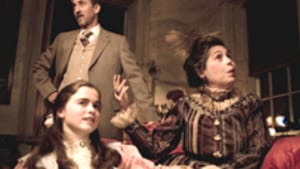Stay in the Loop
BSR publishes on a weekly schedule, with an email newsletter every Wednesday and Thursday morning. There’s no paywall, and subscribing is always free.
Is there a therapist in the house?
A therapist in the theater

In all my years as a family therapist, I have never seen a psychiatric diagnosis that explained the life longings and direction of one of my clients. Or that touched one tiny molecule of a soul or expressed any part of the yearnings of a heart. I am not sure when the first inkling of realization dawned on me, but now I believe it with passion: Those of us who study to become psychotherapists should find some way to understand the dilemmas and challenges of humankind other than the insulting, pigeonholing diagnostic labels of insurance forms that effectively reduce human beings to mice in laboratories.
Instead, I’m now convinced, we should learn about our clients by studying the arts— all of them: novels, plays, biography, music, painting, dance, sculpture, and architecture. This is the truest and most respectful route I can think of to begin a healing process.
There hasn’t been one person I’ve ever worked with, in or out of a psychiatric hospital, who isn’t far more than the diagnosis pinned to him or her. On hospital rounds I’ve often cringed when I heard people described like carburetors, devoid of a first name, or family description, or any sort of observation about the patient’s favorite music or TV shows, or the point at which the patient’s eyes became misty with tears or lit up with laughter.
Once several years ago, during a theater intermission for a summer production of Sondheim’s A Little Night Music, I was approached by a beautiful woman about my age who told me that we’d once worked together; she named the hospital where the work took place. At first I assumed she was a fellow social worker, but then I recognized her as a former inpatient with whom I’d spent many long hours. “They’re playing our song tonight,” she smiled.
She referred, of course, to “Send in the Clowns,” as well as to my attempt to help her see that we’re all in the same boat. That is, we’re all clowns, and we’d all do well to be able to laugh at ourselves. Once blessed with such awareness, we can make choices that can lead to love, expression and fulfillment.
Making dreams come true
The arts can do that. They offer healing communion. They help us understand ourselves and view others with compassion. They also explain malice, greed and forces of destruction. In the process, they strengthen our souls. Through art, hope is restored, insight achieved, and dreams (personal and political) have a greater chance to come true.
Rodgers and Hammerstein’s South Pacific brought its extraordinarily courageous treatment of race prejudice to Broadway in 1949. And in a revival production following Barack Obama’s election it was still meaningful— in a very different way— to a sobbing audience during Lieutenant Cable’s solo, “You’ve Got to be Taught.” And how many angry and confused sons have found solace in meeting the tormented fathers in Arthur Miller’s All My Sons and Death of a Salesman?
Alan Ball, the creator of one the most profound TV experiences, “Six Feet Under,” has now given us “True Blood.” Ostensibly this spellbinding TV drama deals with the world of vampires, but in truth it’s a modern rendition of Romeo and Juliet. We see how things are not what they seem, and how jealousy and envy blend to threaten love. We see how easily a veneer of sanctimonious “goodness” veils an evil pathology.
When actors mistreat their characters
To be sure, I have often left the theater feeling that an important and poignant character has been treated with superficial callousness. I cannot tell you how many times I have wished I could have telephoned the director to tell him (almost always him) about the people I’ve known who have become the play’s character, and how it happened.
At such times it helps to have a family connection. As it happens, my daughter-in-law, Deborah Block, is the co-artistic director for Philadelphia’s Theatre Exile as well as director of the company's current production, Carlos Murillo's dark play, or stories for boys. To Deborah I have often vented my frustrations that actors are often unprepared to understand the life events that have molded some characters— especially the seemingly cruel or despicable ones, who are often played without the dimension they deserve. In other words: How could someone do such horrible, inexcusable things? And why do some people submit to such behavior?
Perhaps to placate me, not long ago Deborah and Exile’s founder, Joe Canuso, made me an offer I couldn’t refuse: They asked me to be “resident artist” for their second production of this season, David Harrower’s highly unsettling Blackbird (Feb. 5-Mar. 1, 2009). This play, written as a love story, focuses on a haunting sexual relationship between a 41-year-old man and a prepubescent girl/emerging woman.
It’s the sort of union that would never be condoned in the real world. And many theatergoers, perhaps most, will find it despicable even on stage. My challenge will be to speak with the artists, however they wish, about people I’ve worked with who’ve experienced some of the issues we’ll see on stage. It will be my chance to put into practice, at last, what until now I have only imagined in theory: the fusion of art and therapy.
To read reviews of Blackbird, click here and here.
Instead, I’m now convinced, we should learn about our clients by studying the arts— all of them: novels, plays, biography, music, painting, dance, sculpture, and architecture. This is the truest and most respectful route I can think of to begin a healing process.
There hasn’t been one person I’ve ever worked with, in or out of a psychiatric hospital, who isn’t far more than the diagnosis pinned to him or her. On hospital rounds I’ve often cringed when I heard people described like carburetors, devoid of a first name, or family description, or any sort of observation about the patient’s favorite music or TV shows, or the point at which the patient’s eyes became misty with tears or lit up with laughter.
Once several years ago, during a theater intermission for a summer production of Sondheim’s A Little Night Music, I was approached by a beautiful woman about my age who told me that we’d once worked together; she named the hospital where the work took place. At first I assumed she was a fellow social worker, but then I recognized her as a former inpatient with whom I’d spent many long hours. “They’re playing our song tonight,” she smiled.
She referred, of course, to “Send in the Clowns,” as well as to my attempt to help her see that we’re all in the same boat. That is, we’re all clowns, and we’d all do well to be able to laugh at ourselves. Once blessed with such awareness, we can make choices that can lead to love, expression and fulfillment.
Making dreams come true
The arts can do that. They offer healing communion. They help us understand ourselves and view others with compassion. They also explain malice, greed and forces of destruction. In the process, they strengthen our souls. Through art, hope is restored, insight achieved, and dreams (personal and political) have a greater chance to come true.
Rodgers and Hammerstein’s South Pacific brought its extraordinarily courageous treatment of race prejudice to Broadway in 1949. And in a revival production following Barack Obama’s election it was still meaningful— in a very different way— to a sobbing audience during Lieutenant Cable’s solo, “You’ve Got to be Taught.” And how many angry and confused sons have found solace in meeting the tormented fathers in Arthur Miller’s All My Sons and Death of a Salesman?
Alan Ball, the creator of one the most profound TV experiences, “Six Feet Under,” has now given us “True Blood.” Ostensibly this spellbinding TV drama deals with the world of vampires, but in truth it’s a modern rendition of Romeo and Juliet. We see how things are not what they seem, and how jealousy and envy blend to threaten love. We see how easily a veneer of sanctimonious “goodness” veils an evil pathology.
When actors mistreat their characters
To be sure, I have often left the theater feeling that an important and poignant character has been treated with superficial callousness. I cannot tell you how many times I have wished I could have telephoned the director to tell him (almost always him) about the people I’ve known who have become the play’s character, and how it happened.
At such times it helps to have a family connection. As it happens, my daughter-in-law, Deborah Block, is the co-artistic director for Philadelphia’s Theatre Exile as well as director of the company's current production, Carlos Murillo's dark play, or stories for boys. To Deborah I have often vented my frustrations that actors are often unprepared to understand the life events that have molded some characters— especially the seemingly cruel or despicable ones, who are often played without the dimension they deserve. In other words: How could someone do such horrible, inexcusable things? And why do some people submit to such behavior?
Perhaps to placate me, not long ago Deborah and Exile’s founder, Joe Canuso, made me an offer I couldn’t refuse: They asked me to be “resident artist” for their second production of this season, David Harrower’s highly unsettling Blackbird (Feb. 5-Mar. 1, 2009). This play, written as a love story, focuses on a haunting sexual relationship between a 41-year-old man and a prepubescent girl/emerging woman.
It’s the sort of union that would never be condoned in the real world. And many theatergoers, perhaps most, will find it despicable even on stage. My challenge will be to speak with the artists, however they wish, about people I’ve worked with who’ve experienced some of the issues we’ll see on stage. It will be my chance to put into practice, at last, what until now I have only imagined in theory: the fusion of art and therapy.
To read reviews of Blackbird, click here and here.
Sign up for our newsletter
All of the week's new articles, all in one place. Sign up for the free weekly BSR newsletters, and don't miss a conversation.

 SaraKay Smullens
SaraKay Smullens